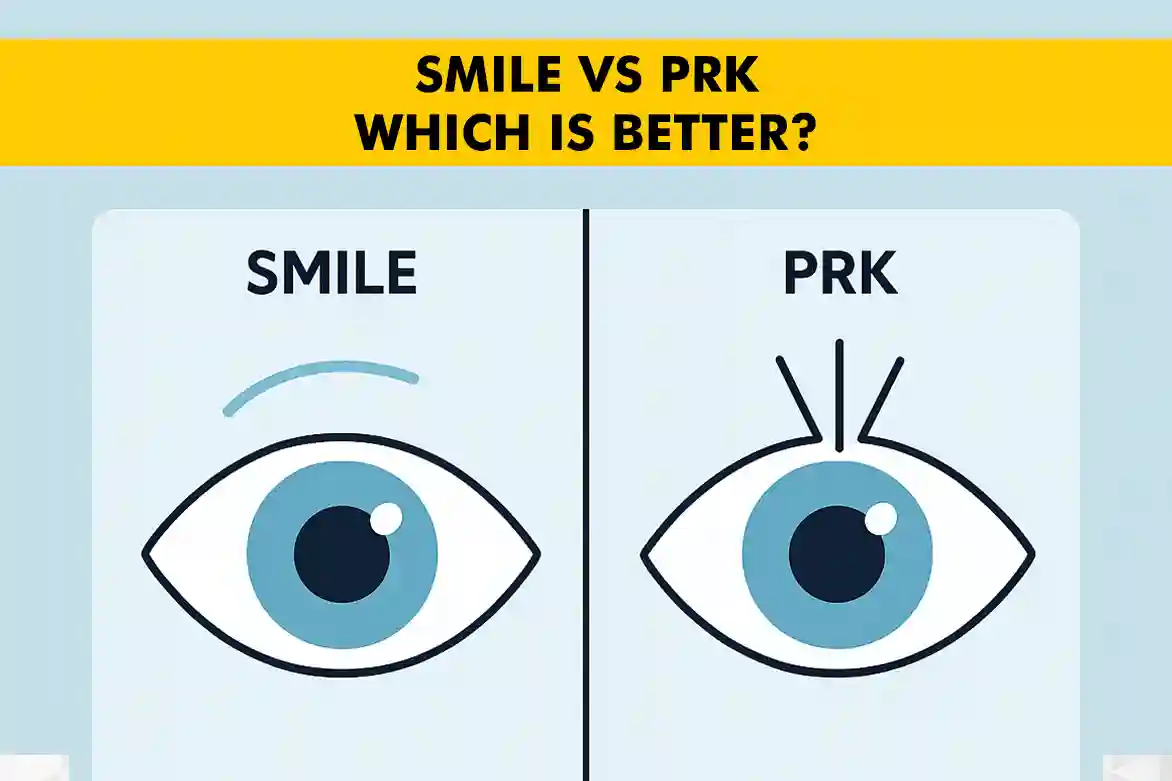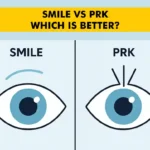For many years, LASIK surgery has been the preferred choice for those seeking vision correction, offering a reliable solution to improve eyesight. However, as medical technology continues to evolve, new and innovative procedures have emerged, providing patients with a broader spectrum of options. Among these advancements are SMILE surgery and PRK eye surgery, each bringing distinct advantages to the table. This blog is dedicated to exploring these cutting-edge alternatives, delving into their unique benefits and potential drawbacks to equip you with the knowledge needed to make a well-informed decision about your vision correction journey. By understanding the nuances of each procedure, you can better assess which option aligns with your specific needs and lifestyle.
What Are LASIK Alternatives?
Alternatives to LASIK include SILK, ICL, Smart Surface, Custom Eyes, SMILE (Small Incision Lenticule Extraction), PRK (Photorefractive Keratectomy), LASEK and Epi-LASIK.
- SILK (Smooth Incision Lenticule Keratomileusis) is a procedure similar to SMILE, where a laser is used to create a lenticule within the cornea, which is then removed through a small incision.
- SMILE is a minimally invasive technique that uses a laser to remove a small piece of corneal tissue, offering a quick recovery and reduced risk of dry eyes.
- Smart Surface is a no-touch laser vision correction method that uses advanced laser technology to reshape the cornea without any physical contact.
- Custom Eyes refers to personalized laser eye surgery by using detailed measurements and wavefront technology. It Custom Eyes aims to enhance visual outcomes and reduce side effects like halos and glare, providing a more precise correction.
- PRK surgery involves reshaping the cornea by removing the outer layer, suitable for those with thinner corneas but has a longer recovery time.
- ICL (Implantable Collamer Lens) involves placing a biocompatible lens inside the eye, between the iris and the natural lens. This option is ideal for individuals with high refractive errors or thin corneas.
Understanding SMILE Surgery: A Modern Vision Correction Technique
Preparation for SMILE Surgery:
- The patient undergoes a comprehensive eye examination to assess suitability for the procedure.
- Detailed measurements of the cornea are taken to plan the surgery accurately.
- The patient is briefed on the procedure, recovery expectations, and potential risks.
Procedure Steps:
- The patient is positioned comfortably, and anesthetic eye drops are applied to numb the eye.
- A femtosecond laser is used to create a small, lens-shaped piece of tissue, known as a lenticule, within the cornea.
- A tiny incision is made on the cornea’s surface to access the lenticule.
- The surgeon carefully removes the lenticule through the incision, which reshapes the cornea to correct vision.
- The incision is so small that it heals naturally without the need for stitches.
Post-Procedure and Recovery:
- The patient is monitored briefly after the procedure to ensure there are no immediate complications.
- Instructions are provided for postoperative care, including the use of prescribed eye drops to prevent infection and manage inflammation.
- Patients typically experience a quick recovery, with many resuming normal activities within a few days.
- Follow-up appointments are scheduled to monitor healing and ensure optimal visual outcome
Understanding PRK Eye Surgery: A Flapless Vision Correction Technique
- Pre-Surgery Examination: The patient undergoes a comprehensive eye examination to assess their suitability for PRK surgery.
- Anesthetic Application: On the day of the surgery, anesthetic eye drops are applied to numb the eye, ensuring the patient remains comfortable throughout the procedure.
- Epithelium Removal: The surgeon carefully removes the epithelium, which is the outer layer of the cornea, to access the underlying tissue.
- Corneal Reshaping: An excimer laser is used to precisely reshape the cornea, correcting the patient’s vision.
- Protective Lens Placement: After the laser treatment, a protective contact lens is placed over the eye to aid in the healing process.
- Postoperative Care Instructions: The patient receives detailed instructions for postoperative care, including the use of prescribed eye drops to prevent infection and manage any discomfort.
- Follow-Up Appointments: Regular follow-up appointments are scheduled to monitor the healing process and ensure the best possible visual outcome.
The Benefits and Drawbacks of PRK
Benefits of PRK:
- Does not require the creation of a corneal flap, making it suitable for patients with thinner corneas.
- Utilizes an excimer laser to reshape the corneal tissue, providing effective vision correction.
Drawbacks of PRK:
- Involves a longer recovery time compared to LASIK and SMILE.
- Patients may experience discomfort during the initial healing period.
Comparing SMILE Surgery vs. PRK Eye Surgery
| ASPECTS | SMILE | PRK |
| Recovery Time | Quicker recovery, often within a few days | Longer recovery, potentially a few weeks |
| Comfort | More comfortable post-procedure | Can be more uncomfortable initially |
| Corneal Suitability | Suitable for a range of corneal conditions | Ideal for patients with thinner corneas |
| Procedure Technique | Minimally invasive, small incision | Involves removal of the corneal epithelium |
| Risk of Dry Eyes | Reduced risk compared to other procedures | Higher risk due to epithelial removal |
| Eligibility | Not suitable for extremely thin corneas | Suitable for those not who are not fit for LASIK |
Is PRK Better Than SMILE Surgery?
Photorefractive Keratectomy (PRK) may be considered a better option than Small Incision Lenticule Extraction (SMILE) for certain individuals, particularly those with specific corneal conditions or who engage in activities that could risk corneal stability. Unlike SMILE, which involves a small incision to remove a lenticule from the cornea, PRK eye surgery does not require any incision, making it a safer choice for patients with thinner corneas or those at risk of corneal trauma. Although PRK generally involves a longer recovery period compared to SMILE, it provides a more stable and secure solution for individuals with particular corneal characteristics. The decision between PRK and SMILE should be guided by a thorough evaluation of the patient’s corneal thickness, lifestyle, and potential risk factors, ensuring the selected procedure meets their unique needs and circumstances.
Conclusion
Both SMILE and PRK present viable alternatives to LASIK for vision correction, each with its own set of benefits and considerations. Making an informed decision between these procedures requires careful evaluation of several factors, such as your specific eye conditions, lifestyle, and personal preferences. Engaging in a professional consultation with an eye care specialist is crucial, as they can provide expert guidance tailored to your unique needs. This consultation will help you understand the nuances of each procedure, enabling you to make a well-informed choice that aligns with your vision correction goals.
FAQs:
SMILE generally has a quicker recovery time compared to PRK. Patients undergoing SMILE can often return to normal activities within a few days, whereas PRK may require a longer healing period and more postoperative care.
PRK can be more uncomfortable than SMILE during the initial recovery phase due to the removal of the corneal epithelium. Post-surgery management and proper care are crucial during this time.
Both SMILE and PRK offer similar vision correction results, but individual outcomes can vary based on various factors, including the surgeon’s expertise and the patient’s specific eye condition.
Patients with certain types of corneal irregularities or extremely thin corneas may not be eligible for SMILE or PRK. A thorough eye examination and consultation with a specialist are necessary to determine eligibility.
PRK recovery typically takes longer than SMILE, with full visual acuity potentially taking several weeks to months to achieve. Proper postoperative care and follow-up visits are essential for optimal recovery.





